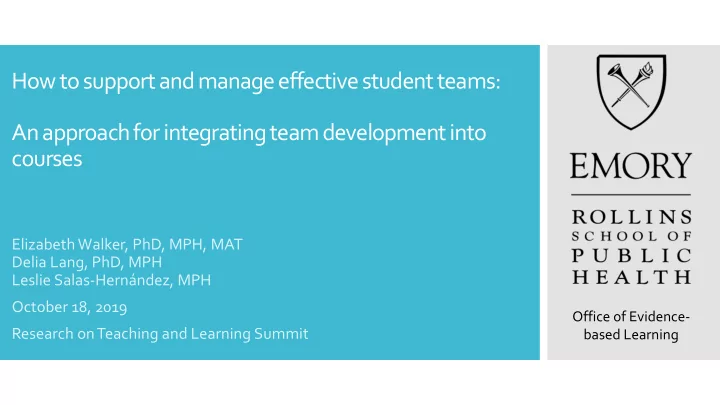

How to support and manage effective student teams: An approach for integrating team development into courses Elizabeth Walker, PhD, MPH, MAT Delia Lang, PhD, MPH Leslie Salas-Hernández, MPH October 18, 2019 Office of Evidence- Research on Teaching and Learning Summit based Learning
Teamwork in Your Teaching How do you use teamwork in your teaching? What challenges have you encountered? What works well?
By the end of the session, you will be able to: Learning • Describe activities that can be implemented in a course to support team development. objectives • Discuss the challenges and facilitators for supporting team development in their courses. • Develop a plan for integrating team development activities into their courses
Improvements in academic success Team-based Background approaches Learn and practice skills for collaboration Kalaian & Kasim. (2017). Effectiveness of various innovative learning methods in health science classrooms: a meta-analysis. Advances in Health Sciences Education , 22(5), 1151-1167. Lang et al. (2018). Implementation and mixed-methods evaluation of Team-Based Learning in a graduate public health research methods course. Pedagogy in Health Promotion , 4(2), 140 – 150. Tollison & Turner. (2018). Cooperating Across Classrooms: Cooperative – Experiential Learning Through Design and Implementation of Health Campaign Messages. Pedagogy in Health Promotion , 4(1), 52-57.
Background Teams Success
Background Teams Team skills Success
Framework Social Constructivist Learning Theory • Students learn by interacting with each other. • Collaborative problem-solving • Co-constructing knowledge and skills • Reflecting on and integrating new knowledge
Setting & Experiences Research Methods in Health Promotion • Team-based Learning format • Evaluation of team processes
1. Setting the foundation Strategies for 2. Peer evaluations Integrating Team 3. Team reflections Development 4. Self-reflection
• Communication styles Early assessment dedication • Ice breaker & team name 1. Setting the of time to • Discussion on Foundation communication styles team and working expectations building • Develop team rules
Common categories for team rules • Norms for working together • Communicating with group members 1. Setting the • Creating a safe space for everyone’s Foundation opinion • Coming to class prepared • Encouraging team members to work out of their “comfort zone”
• Mid and end of semester • Students assign each team member and themselves up to 10 points Assessing 2. Peer • Justify ratings, based on: contributions Evaluation • Preparation to the team • Contribution • Respect for other’s ideas • Flexibility Process adapted from: Michaelsen, L. K., Knight, A. B., & Fink, L. D. (2004). Team-based Learning: A transformative use of small groups in college teaching. Sterling, VA: Stylus.
Rating patterns • Generally, rise from mid- to end of the semester Common areas for improvement • Not prepared for class 2. Peer • Distracted during class • Not flexible or open to others’ ideas Evaluation • Not respectfully responding to others when they disagreed Changes over the semester • “She was not always a big contributor but definitely started contributing more towards the end of the semester. I really appreciate her contribution because I think she has a solid understanding of the material.”
• Mid-semester: Assess team Regroup, dynamics and plan 3. Team refocus, for addressing Reflection challenges reflect • End of semester: Reflect on progress
Common topics that teams addressed • Assigning roles for completing work • Communication between teammates • Remaining focused on the tasks in class 3. Team Reflection Benefit of team reflection • “Once we admitted that we were having trouble, we were able to work through the problems and address them together.”
• Experience in class • Working with Written 4. Self- reflection reflections team • Contributions to learning
Common topics of reflection • Role of peers in learning • Growth in confidence • Value of working in teams 4. Self- Benefit of team work reflection • “It was great being in a group setting where the purpose of being in a group…[was] helping each other see things in a new way and have a more well-rounded understanding of the material. I have learned that using my peers as a resource is a better way to learn than using just my professor and textbook.”
How easy or hard would it be to use some of these strategies in your teaching? Integrating Team Development To what extent do these in Your Teaching strategies address any of the challenges we discussed earlier?
Integrating Team Development in Your Teaching Brainstorm ways to incorporate team development into your teaching. • Which strategies could you incorporate into your teaching? • How would you use the strategies?
Benefits • Fosters development of team skills Integrating • Students value practice of team skills Team • Provides formative feedback for course Development improvement in Your Challenges Teaching • Requires time from course content • Requires advance planning and coordination
Integrating Team Strategies Development Teams to promote Team skills Success team skills in Your Teaching
Thank you! Questions? To contact us: • Liz Walker – ereisin@emory.edu Office of Evidence- • Delia Lang – dlang2@emory.edu based Learning
Recommend
More recommend